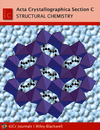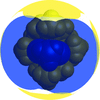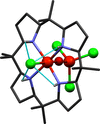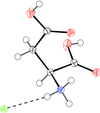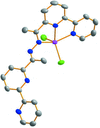issue contents
July 2014 issue

Cover illustration: Polyhedral model of [U(SO4)2(H2O)5]·H2O, viewed down the a axis, showing the herringbone chain connectivity in the direction of the c axis. See Burns, Patrick, Lam & Dreisinger [Acta Cryst. (2014), C70, 726-731].
editorial
Free 

research papers
Download citation


Download citation


Both acetate and acetamide anions are well known as ligands, but why are there so few complexes with an acetamide as a chelon? A side-by-side comparison suggests these ligands could be viewed as different electronic versions of each other.
Download citation


Download citation


An iron(III) calix[4]pyrrolidine complex undergoes a slow phase transformation at ca 173 K from monoclinic space group P21/n to the maximal non-isomorphic subgroup, triclinic space group P , which is accompanied by nonmerohedral twinning. The NH H atoms are directed below the planes of the macrocycles and are hydrogen bonded to the coordinated Cl− ions. There are also intramolecular C—H⋯Cl hydrogen bonds present in both forms.
, which is accompanied by nonmerohedral twinning. The NH H atoms are directed below the planes of the macrocycles and are hydrogen bonded to the coordinated Cl− ions. There are also intramolecular C—H⋯Cl hydrogen bonds present in both forms.
Download citation


Download citation


A lead(II) complex has been prepared by reaction of Pb(OAc)2·2H2O (OAc is acetate) with 2,2′-(diazene-1,2-diyl)dibenzoic acid and 4,4′-bipyridine in MeOH–H2O at 363 K. Single-crystal X-ray diffraction analysis reveals that the complex possesses a three-dimensional framework with a 41263 topology.
CCDC reference: 1005925
Download citation


Download citation


In a new one-dimensional cobalt(II) coordination polymer with 2-(4-carboxyphenoxy)benzoate (Hoba−) and 4,4′-bipyridine (bipy) ligands, the CoII ions are connected by bipy ligands to form an infinite one-dimensional chain. O—H⋯O hydrogen bonding extends these chains into a two-dimensional supramolecular architecture.
CCDC reference: 1005073
Download citation


Download citation


In a centrosymmetric bis-substituted 2-bromo-4-chloro-6-{[(2-hydroxyethyl)imino]methyl}phenolate copper(II) complex, the CuII centre is coordinated in a square-planar geometry and the hydrogen-bond network is built from infinite two-dimensional layers formed by O—H⋯O hydrogen bonds between hydroxyethyl groups.
CCDC reference: 1005486
Download citation


Download citation


The crystal structures of three products of the reaction of 2-phenylphenol and BCl3 have been determined. The structures show intriguing packing patterns and an interesting case of pseudosymmetry. In addition, one of the two polymorphs has a primitive monoclinic crystal system, but it is twinned and emulates an orthorhombic C-centred structure.
Download citation


Download citation


Numerous charge-assisted hydrogen bonds and π–π interactions link the counter-ions of tetrakis(4-aminopyridinium) perylene-3,4,9,10-tetracarboxylate octahydrate into a three-dimensional framework. From the viewpoint of topology, each anion acts as a 16-connected node by hydrogen bonding to six cations and ten water molecules to yield a highly connected hydrogen-bonding framework.
CCDC reference: 1006659
Download citation


Download citation


In a hydrated cadmium chloride salt, the asymmetric unit comprises two N-protonated 5-amino-3-carboxy-4H-1,2,4-triazol-1-ium cations, half a [CdCl6]4− anion and two molecules of water. Alternating layers of cations and anions are arranged along the [101] direction, forming a three-dimensional supramolecular network via a combination of hydrogen-bonding and aromatic stacking interactions.
CCDC reference: 1006349
Download citation


Download citation


Two independent π–π stacking interactions link the molecules of (E)-3-{4-[(7-chloroquinolin-4-yl)oxy]-3-methoxyphenyl}-1-(4-methylphenyl)prop-2-en-1-one, but hydrogen bonds are absent from the structure.
CCDC reference: 1007823
Download citation


Download citation


4-Nitrobenzene-1,2-diamine and two hydrohalide salts exhibit extensive hydrogen bonding resulting in two- and three-dimensional networks. The structural results are used in conjuction with DFT calculations to estimate the strength of the N—H⋯O(nitro) interactions.
Download citation


Download citation


The crystal structures of two polymorphs of L-aspartic acid hydrochloride revealed three- and two-dimensional hydrogen-bonding networks for the triclinic and orthorhombic polymorphs, respectively. The polymorphs share common structural features; however, the conformations of the L-aspartate cations and the crystal packings are different.
Download citation


Download citation


A chiral two-dimensional lead(II) coordination polymer containing right-handed helical chains has been prepared under hydrothermal conditions using an achiral organic 3-carboxybenzene-1,2-dicarboxylate linker ligand. The thermogravimetric and optical properties are also reported.
CCDC reference: 1007893
Download citation


Download citation


Crystals of hexa-tert-butyldisilane undergo a reversible phase transition at 179 (2) K. The space group changes from Ibca (high temperature) to Pbca (low temperature), but the lattice constants a, b and c do not change significantly during the phase transition. In a new polymorph of 1,1,2,2-tetra-tert-butyl-1,2-diphenyldisilane, two independent molecules have rather similar conformations.
Download citation


Download citation


Coordination polymer chains built from CuII and adipate ions are linked into a framework structure by hydrogen bonds and π–π stacking interactions involving 2,2′-bipyridine and 1,1,3,3-tetracyano-2-ethoxypropenide components.
CCDC reference: 1007824
Download citation


Download citation


The crystal structure of 8-oxo-5,10,15,20-tetraphenyl-7-oxaporphyrin N24-oxide is compared with its isomer, 8-oxo-5,10,15,20-tetraphenyl-7-oxaporphyrin N22-oxide, carrying the N-oxide at the opposing nitrogen, and the parent tetraarylporphyrin N-oxide. A detailed conformational analysis reveals subtle differences in the nonplanar conformations of their chromophores.
CCDC reference: 1008298
Download citation


Download citation


In a CdII coordination polymer formed by 3,3′-thiodipropionate and 4,4′-(propane-1,3-diyl)dipyridine ligands, the CdII centres are bridged through carboxylate O atoms and pyridine N atoms to form two different one-dimensional chains which intersect to form a two-dimensional layer. These two-dimensional layers are linked by S atoms to form a three-dimensional network.
CCDC reference: 998995
Download citation


Download citation


A manganese(II) coordination polymer based on thiophene-3,4-dicarboxylate was synthesized hydrothermally. The thiophene-3,4-dicarboxylate ligand adopts a novel hexadentate chelating and μ5-bridging coordination mode.
CCDC reference: 1008743
Download citation


Download citation


A supramolecular architecture based on C—H⋯Cl and π–π stacking interactions was obtained for a mononuclear MnII complex incorporating chloride and 2,5-bis(2,2′-bipyridyl-6-yl)-3,4-diazahexa-2,4-diene ligands.
CCDC reference: 1008615
Download citation


Download citation


A one-dimensional double-chain zinc(II) complex with phthalate and 2-[3-(pyridin-2-yl)-1H-pyrazol-1-yl]acetate (PPAA−) ligands has been prepared by solvothermal reaction of 2-[3-(pyridin-2-yl)-1H-pyrazol-1-yl]acetonitrile (PPAN) with zinc(II), the PPAN being hydrolyzed to PPAA−. The one-dimensional double chains are extended into a three-dimensional supramolecular architecture via hydrogen-bonding and π–π stacking interactions.
CCDC reference: 1008809
Download citation


Download citation


Two new uranium(IV) sulfate x-hydrates, where x is the total number of coordinated plus solvent waters, have been characterized and compared to other known uranous sulfate x-hydrates. As the number of coordinated waters increases, the structure transitions from being fully crosslinked through sulfate bridging in three dimensions in the anhydrous compound, through sheet and chain linking in the tetra- and hexahydrate, to fully unlinked molecules in the octa- and nonahydrate.


 journal menu
journal menu








